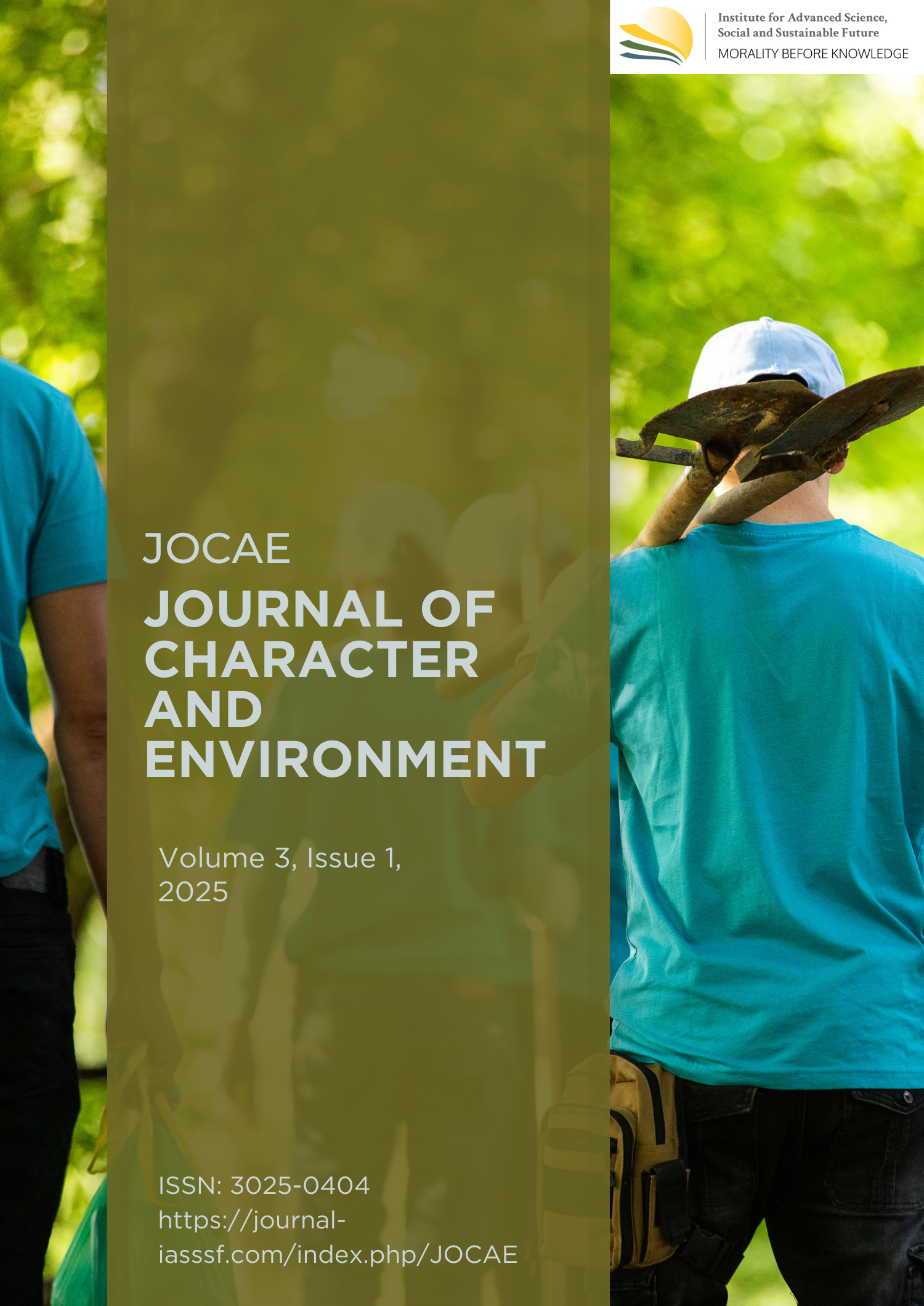The behavioral changes of birds as a result of urban noise levels
DOI:
https://doi.org/10.61511/jocae.v3i1.2025.2077Keywords:
birds, forest city, noiseAbstract
Background: Bird conservation in Indonesia is still focused on the areas of conservation of specified government. As in the nature reserves, wildlife clan asylum and national park. Nevertheless there are birds that live outside conservation areas such as forest city. DKI Jakarta as the capital city of Indonesia with a population of the most populous and has a forest city as a habitat of birds in urban areas, it become necessary to know research, equity, diversity, wealth, abundance, similarity species of birds, the difference in noise level and noise influence toward activity-voiced bird in three forest city of DKI Jakarta. Methods: Data retrieval method using point count with 24 point edge and central region in each forest city. Findings: Based on the findings presented in Chapter IV of the thesis, the study showed that higher noise levels and greater human presence significantly reduced bird vocal activity across three urban forests in Jakarta. The average noise level was highest in PT JIEP City Forest (66.55 dB), while human activity peaked in Hutan Kota Srengseng with 152 individuals recorded. A statistically relevant pattern was found: bird vocalization activity and the number of vocalizing birds were highest in areas with lower noise and human presence, supporting the hypothesis that anthropogenic disturbance negatively impacts bird behavior. Conclusion: This study reveals that noise levels and human presence significantly affect bird vocal activity and species diversity in urban forests of Jakarta, with lower noise and fewer people correlating with higher bird sound activity and diversity, highlighting the ecological importance of preserving and managing these green spaces. Novelty/Originality of this article: This study presents a novel investigation by integrating spatial (edge vs. center zones).
References
Alikodra. (2002). Pengelolaan satwa liar. Fakultas Kehutanan, Institut Pertanian Bogor.
Ben-Noun, L. (2023). The relationship of birds to human health "I know all the birds of the mountains". B.N. Publication House.
Bibby, C., Kartikasari, S. N., Marsden, S., & Shannas, J. (2000). Teknik-teknik ekspedisi lapangan: Survey burung. BirdLife International Indonesia Programme.
Brumm, H. (2004). The impact of environmental noise on song amplitude in a territorial bird. Journal of Animal Ecology, 73(3), 434–440. https://www.jstor.org/stable/3505653
Indonesian Birds. (2025). The state of Indonesia’s birds 2025. Indonesian Birds. https://burung.org/en/bird-information/the-state-of-indonesias-birds-2025/
Catchpole, C. K., & Slater, P. J. (2003). Bird song: Biological themes and variations. Cambridge University Press.
Doelle, L. L. (1993). Akustik lingkungan (Prasetio, L., Penerj.). Erlangga. https://lib.ui.ac.id/detail?id=13386&lokasi=lokal
Dooling, R. J., & Popper, A. N. (2007). The effects of highway noise on birds. The California Department of Transportation Division of Environmental Analysis.
Fandeli, C. (2001). Kriteria pembangunan hutan kota dalam perspektif lingkungan. Makalah Workshop Hutan Kota. Fakultas Kehutanan UGM, Yogyakarta.
Fuller, R. A., Warren, P. H., & Gaston, K. J. (2007). Daytime noise predicts nocturnal singing in urban robins. Biology Letters, 3(4), 368–370. https://doi.org/10.1098/rsbl.2007.0134
Goller, F., & Larsen, O. N. (1997). A new mechanism of sound generation in songbirds. Proceedings of the National Academy of Sciences, 94(26), 14787–14791. https://doi.org/10.1073/pnas.94.26.14787
Hayes, W. M., O’Shea, B. J., Pierre, M. A., Wilson, A., & Bicknell, J. E. (2023). Bird communities across different levels of human settlement: A comparative analysis from two northern Amazonian ecoregions. Science of the Total Environment, 903(May), 166535. https://doi.org/10.1016/j.scitotenv.2023.166535
Haryadi, D. S. (2016). Komunitas burung passerine di dua hutan kota dengan tingkat kebisingan berbeda. Skripsi, Universitas Indonesia.
Hernowo, J. B., & Prasetyo, L. B. (1989). Konsepsi ruang terbuka hijau di kota sebagai pendukung pelestarian burung. Fakultas Kehutanan, Institut Pertanian Bogor. http://repository.ipb.ac.id/handle/123456789/10928
Herrera-Montes, M. I., & Aide, T. M. (2011). Impacts of traffic noise on anuran and bird communities. Urban Ecosystems, 14, 415–427. https://doi.org/10.1007/s11252-011-0158-7
Irwan, D. Z. (1994). Peranan bentuk dan struktur kota terhadap kualitas lingkungan kota. Disertasi, Pascasarjana Institut Pertanian Bogor.
Jiang, H., Ding, Z., Liang, J., Li, H., Chen, D., Liu, Q., Huang, S., Wu, L., & Xing, X. (2025). Evidence of niche packing among bird species from analyses of functional trait patterns along an urbanization gradient in South China. Global Ecology and Conservation, 63, e03873. https://doi.org/10.1016/j.gecco.2025.e03873
King, A. S. (1989). Functional analysis of the syrinx. In A. S. King & J. McLelland (Eds.), Form and function in birds (Vol. 4). Academic Press. https://www.cabidigitallibrary.org/doi/full/10.5555/19802257036
Krebs, C. J. (1989). Ecological methodology. Harper & Row Inc. Publisher.
Kurnia, I., Arief, H., Mardiastuti, A., & Hermawan, R. (2021). The potential of bird diversity in the urban landscape for birdwatching in Java, Indonesia. Biodiversitas, 22(4), 1701–1711. https://doi.org/10.13057/biodiv/d220413
MacKinnon, J. (1995). Panduan lapangan pengenalan burung-burung di Jawa dan Bali. UGM Press.
MacKinnon, J. R., Phillipps, K., & van Balen, S. (1999). Burung-burung di Sumatera, Jawa, Bali dan Kalimantan: Termasuk Sabah, Sarawak dan Brunei Darussalam. Puslitbang Biologi-LIPI.
Magurran, A. E. (2004). Measuring biological diversity. Blackwell Scientific.
Marini, A. (1996). Pokok-pokok perhutanan kota. Fakultas Kehutanan, Institut Pertanian Bogor.
Mariyappan, M., Rajendran, M., Velu, S., Johnson, A. D., Dinesh, G. K., Solaimuthu, K., Kaliyappan, M., & Sankar, M. (2023). Ecological Role and Ecosystem Services of Birds: A Review. International Journal of Environment and Climate Change, 13(6), 76–87. https://doi.org/10.9734/ijecc/2023/v13i61800
Marler, P. (2004). Bird calls: Their potential for behavioral neurobiology. Annals of the New York Academy of Sciences, 1016(1), 31–44. https://doi.org/10.1196/annals.1298.034
Maurya, P. (2024). Ecology: Insights Into the Dynamics of Life and Environment. Futuristic Trends in Social Sciences Volume 3 Book 25, May, 65–72. https://doi.org/10.58532/v3bbso25p2ch3
Mediastika, C. E. (2009). Material akustik pengendali kualitas bunyi pada bangunan. Penerbit Andi.
Ministry of Environment. (1996). Keputusan Menteri Lingkungan Hidup Nomor 48 Tahun 1996 tentang Baku Tingkat Kebisingan Lingkungan. Kementerian Lingkungan Hidup. https://id.wikisource.org/wiki/Keputusan_Menteri_Negara_Lingkungan_Hidup_Republik_Indonesia_Nomor_48_Tahun_1996
Morelli, F., Reif, J., Díaz, M., Tryjanowski, P., Ibáñez-Álamo, J. D., Suhonen, J., Jokimäki, J., Kaisanlahti-Jokimäki, M. L., Pape Møller, A., Bussière, R., Mägi, M., Kominos, T., Galanaki, A., Bukas, N., Markó, G., Pruscini, F., Jerzak, L., Ciebiera, O., & Benedetti, Y. (2021). Top ten birds indicators of high environmental quality in European cities. Ecological Indicators, 133. https://doi.org/10.1016/j.ecolind.2021.108397
Naufalianto, I. F. (2025). Influence of Land Surface Temperature and Vegetation Cover on Bird Communities in the Urban Landscape of Yogyakarta. Taprobanica, 14(2). https://doi.org/10.47605/tapro.v14i2.365
Patankar, S., Jambhekar, R., Suryawanshi, K. R., & Nagendra, H. (2021). Which traits influence bird survival in the city? A review. Land, 10(2), 1–23. https://doi.org/10.3390/land10020092
Patón, D., Romero, F., Cuenca, J., & Escudero, J. C. (2012). Tolerance to noise in 91 bird species from 27 urban gardens of Iberian Peninsula. Landscape and Urban Planning, 104(1), 1–8. https://doi.org/10.1016/j.landurbplan.2011.09.002
Peterson, R. T. (1980). Pustaka Life. Tiara Pustaka.
Proppe, D. S., Sturdy, C. B., & St. Clair, C. C. (2013). Anthropogenic noise decreases urban songbird diversity and may contribute to homogenization. Global Change Biology, 19(4), 1075–1084.
Rif’at. (2013). Keanekaragaman jenis burung di Kepulauan Masalembu Sumenep, Jawa Timur. Skripsi, Universitas Islam As-Syafiiyah, Jakarta.
Rombang, W. M., & Rudyanto. (1999). Daerah penting bagi burung Jawa dan Bali. PKA/BirdLife International-Indonesia Programme.
Sherry, T. W. (2021). Sensitivity of Tropical Insectivorous Birds to the Anthropocene: A Review of Multiple Mechanisms and Conservation Implications. Frontiers in Ecology and Evolution, 9(May), 1–20. https://doi.org/10.3389/fevo.2021.662873
Sofyan, H. L. (2013). Analisis cadangan karbon pohon pada lanskap hutan kota di DKI Jakarta. Tesis, Institut Pertanian Bogor.
Suriandjo, H. S., & Tondobala, L. (2013). Response to standard noise with emphasis on soundscapes in the city center. Media Matrasain, 10(1), 36–49. https://doi.org/10.35792/matrasain.v10i1.4089
Tan, L., Huang, R., Hao, P., Huang, Z., & Wang, Y. (2025). Distribution of Bird Communities and Habitat Corridor Composition Shaped by Environmental Factors in Urbanized Landscapes: A Case Study in Beijing, China. Forests, 16(1). https://doi.org/10.3390/f16010001
Welty, J. C. (1982). The life of birds. Saunders College Publishing.
Zoer’aini, D. I. (2005). Tantangan lingkungan dan landskap hutan kota. Bumi Aksara.
Downloads
Published
How to Cite
Issue
Section
Citation Check
License
Copyright (c) 2025 Kusholany, Handayani, Tatang Mitra Setia, Indarjani

This work is licensed under a Creative Commons Attribution 4.0 International License.
















